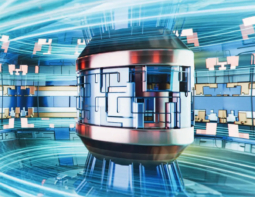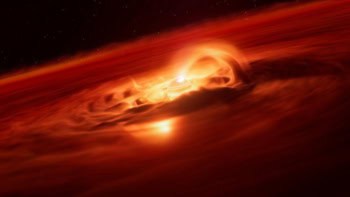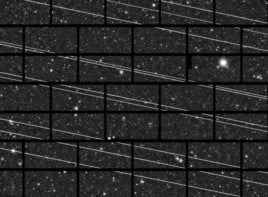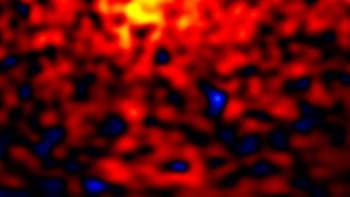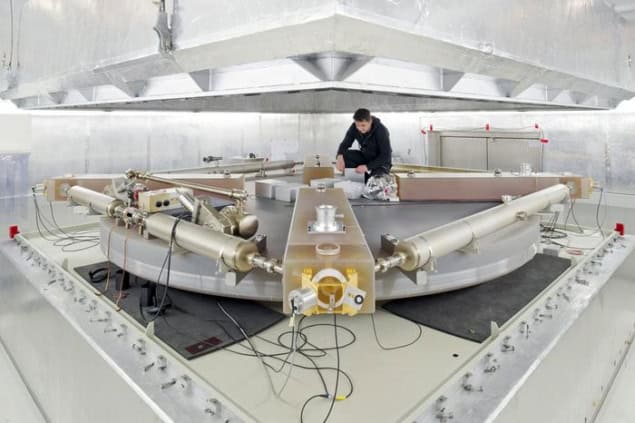
As the Earth moves through space, it wobbles. Researchers in Germany have now directly observed this wobble with the highest precision yet thanks to a large ring laser gyroscope they developed for this purpose. The instrument, which is located in southern Germany and operates continuously, represents an important advance in the development of super-sensitive rotation sensors. If further improved, such sensors could help us better understand the interior of our planet and test predictions of relativistic effects, including the distortion of space-time due to Earth’s rotation.
The Earth rotates once every day, but there are tiny fluctuations, or wobbles, in its axis of rotation. These fluctuations are caused by several factors, including the gravitational forces of the Moon and Sun and, to a lesser extent, the neighbouring planets in our Solar System. Other, smaller fluctuations stem from the exchange of momentum between the solid Earth and the oceans, atmosphere and ice sheets. The Earth’s shape, which is not a perfect sphere but is flattened at the poles and thickened at the equator, also contributes to the wobble.
These different types of fluctuations produce effects known as precession and nutation that cause the extension of the Earth’s axis to trace a wrinkly circle in the sky. At the moment, this extended axis is aligned precisely with the North Star. In the future, it will align with other stars before returning to the North Star again in a cycle that lasts 26,000 years.
Most studies of the Earth’s rotation involve combining data from many sources. These sources include very long baseline radio-astronomy observations of quasars; global satellite navigation systems (GNSS); and GNSS observations combined with satellite laser ranging (SLR) and Doppler orbitography and radiopositioning integrated by satellite (DORIS). These techniques are based on measuring the travel time of light, and because it is difficult to combine them, only one such measurement can be made per day.
An optical interferometer that works using the Sagnac effect
The new gyroscope, which is detailed in Science Advances, is an optical interferometer that operates using the Sagnac effect. At its heart is an optical cavity that guides a light beam around a square path 16 m long. Depending on the rate of rotation it experiences, this cavity selects two different frequencies from the beam to be coherently amplified. “The two frequencies chosen are the only ones that have an integer number of waves around the cavity,” explains team leader Ulrich Schreiber of the Technische Universität München (TUM). “And because of the finite velocity of light, the co-rotating beam ‘sees’ a slightly larger cavity, while the anti-rotating beam ‘sees’ a slightly shorter one.”
The frequency shift in the interference pattern produced by the co-rotating beam is projected onto an external detector and is strictly proportional to the Earth’s rotation rate. Because the accuracy of the measurement depends, in part, on the mechanical stability of the set-up, the researchers constructed their gyroscope from a glass ceramic that does not expand much with temperature. They also set it up horizontally in an underground laboratory, the Geodetic Observatory Wettzell in southern Bavaria, to protect it as much as possible from external vibrations.
The instrument can sense the Earth’s rotation to within an accuracy of 48 parts per billion (ppb), which corresponds to picoradians per second. “This is about a factor of 100 better than any other rotation sensor,” says Schreiber, “and, importantly, is less than an order of magnitude away from the regime in which relativistic effects can be measured – but we are not quite there yet.”

Magnetically launched atoms sense motion
An increase in the measurement accuracy and stability of the ring laser by a factor of 10 would, Schreiber adds, allow the researchers to measure the space-time distortion caused by the Earth’s rotation. For example, it would permit them to conduct a direct test for the Lense-Thirring effect — that is, the “dragging” of space by the Earth’s rotation – right at the Earth’s surface.
To reach this goal, the researchers say they would need to amend several details of their sensor design. One example is the composition of the thin-film coatings on the mirrors inside their optical interferometer. “This is neither easy nor straightforward,” explains Schreiber, “but we have some ideas to try out and hope to progress here in the near future.
“In the meantime, we are working towards implementing our measurements into a routine evaluation procedure,” he tells Physics World.
